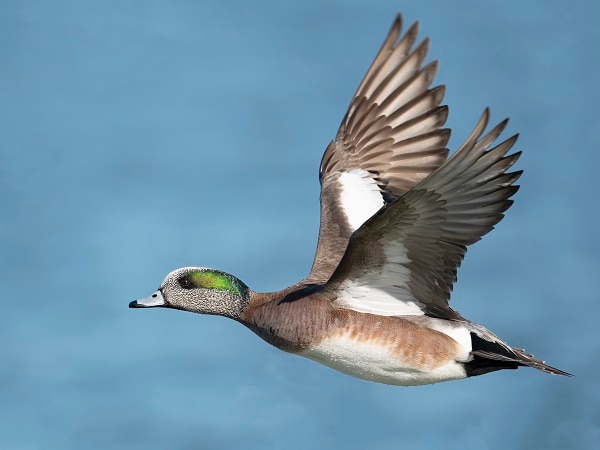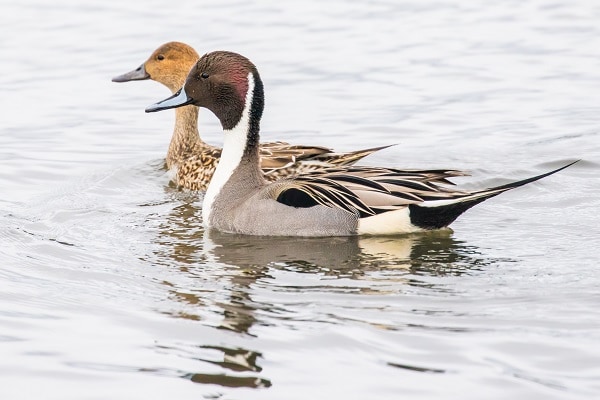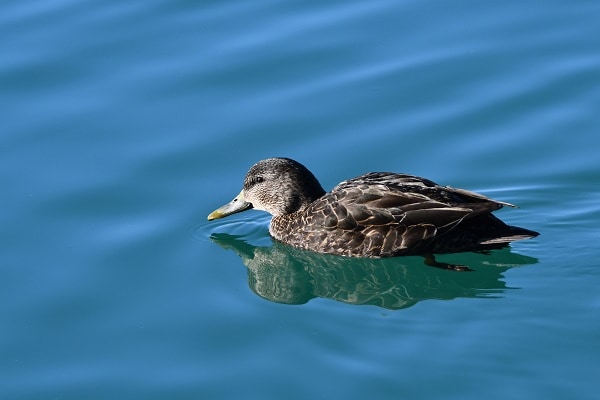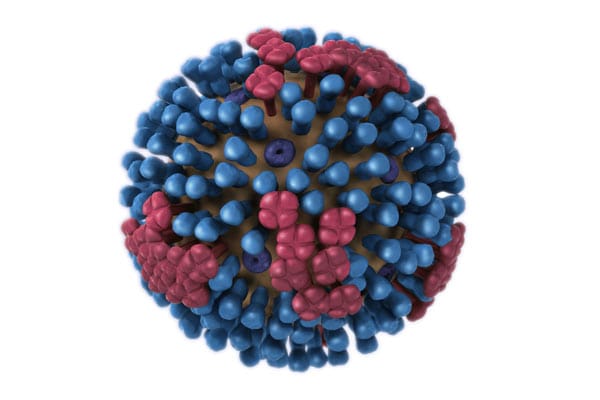Current Bird Flu Situation in Wild Birds

This webpage summarizes the current avian influenza (bird flu) situation both domestically in the United States and globally.

This is a picture of a male American wigeon duck in flight. On January 14, 2022, USDA announced finding H5N1 bird flu in an American wigeon in South Carolina, marking the first detection of this virus in wild birds in the United States since 2016.
Background
Avian influenza (bird flu) refers to disease caused by infection with avian (bird) influenza (flu) Type A viruses. Bird flu viruses can infect the respiratory and gastrointestinal tract of birds and have been identified from more than 100 different species of wild birds around the world. Wild aquatic birds including gulls, terns, and shorebirds, and wild waterfowl such as ducks, geese and swans are considered reservoirs (natural hosts) for bird flu viruses. Most wild birds infected with bird flu viruses are asymptomatic (i.e., do not exhibit signs or symptoms of illness). Some bird flu viruses can infect domestic poultry and other domestic and backyard birds, and outbreaks of bird flu in domestic poultry occur worldwide. For more information: Avian Influenza – WOAH – World Organisation for Animal Health and the WOAH-WAHIS. Some bird flu viruses have infected other mammalian species, and rare, sporadic human infections with some bird flu viruses have occurred (more information is available in the Current U.S. Bird Flu Situation in Humans section).
Domestic Summary
- Highly pathogenic avian influenza (HPAI)* A(H5) viruses have been detected in U.S. wild aquatic birds, commercial poultry and backyard and hobbyist flocks beginning in January 2022. These are the first detections of HPAI A(H5) viruses in the United States since 2016. Preliminary genetic sequencing and RT-PCR testing on some virus specimens shows these viruses are HPAI A(H5N1) viruses from clade 2.3.4.4b.**
- More information is available from the following spotlight articles.
- The latest case reports on bird flu outbreaks in wild birds, commercial poultry, and backyard birds in the United States are available from the USDA website.
- A handout containing information and guidance for people exposed to birds with bird flu is available at What To Know About Bird Flu (cdc.gov) [154 KB, 2 pages].
*Highly pathogenic avian influenza (HPAI) and Low pathogenic avian influenza (LPAI) are described in the “Classification of avian influenza A viruses” section.
**Clades are described in the “Classification of avian influenza A viruses” section.

A pair of northern pintail ducks. Bird flu viruses occur naturally among wild aquatic birds worldwide. Wild aquatic birds include waterbirds (waterfowl) such as ducks, geese, swans, gulls, and terns, and shorebirds, such as storks and plovers.
Global Summary
- In the past decade there have been increases in the reported number and geographic spread of bird flu infections in birds, increases in the number of subtypes of bird flu viruses that have infected birds, and increases in the numbers of bird species that bird flu viruses have infected.
- The largest increase in HPAI A(H5N1) virus outbreaks in poultry and wild birds occurred during 2004-2006,
- During 2013-2021, different HPAI A(H5) and A(H7) virus subtypes as well as low pathogenic avian influenza (LPAI) A(H3), A(H5), A(H6), A(H7), and A(H9) virus subtypes caused animal outbreaks globally.
- Since 2020, there has been a global increase in the number of HPAI A(H5) outbreaks reported in wild birds and poultry. There were more outbreaks reported in 2020-2021 than in the previous four years combined. Europe, Africa, and Southeast Asia reported multiple outbreaks of HPAI A(H5N8) starting in 2020 and HPAI A(H5N1) starting in 2021. During this same time, HPAI A(H5N6) virus outbreaks were reported in Asia, particularly China and Vietnam, and Southeast China (Chinese Taipei) reported outbreaks of HPAI A(H5N2) virus in poultry.
- In 2021, Europe reported multiple outbreaks of HPAI A(H5N5) virus and reported the first outbreaks of HPAI A(H5N4) virus in wild birds.
- In December 2021,HPAI A(H5N1) viruses were detected in birds in Newfoundland, Canada, marking the first identification of this virus in the Americas since June 2015.
- Ancestors of these HPAI A(H5N1) viruses first emerged in Asia in the late 1990s and began spreading widely in birds throughout Asia in 2003, and later spread to Africa, Europe, and the Middle East, causing sporadic human infections.
- Since 2003, multiple different clades of A(H5N1) viruses have circulated over the years, including a clade that was introduced by wild birds into the United States in 2014 and circulated until 2016.
- 54 countries reported H5N1 bird flu outbreaks in birds in 2021 and 2022.
- Specifically, from 2013-2021, the following HPAI and LPAI virus subtypes were reported in animals, mostly in wild aquatic waterfowl or domestic poultry:
- HPAI A(H5) virus subtypes detected included: H5N1, H5N2, H5N3, H5N4, H5N5, H5N6, H5N8, H5N9, and H5Nx***
- HPAI A(H7) virus subtypes detected included: H7N1, H7N2, H7N3, H7N7, H7N8 and H7N9
- LPAI A virus subtypes detected included H3N1, H5N1, H5N2, H5N3, H5N5, H5N6, H5N8, H5N8, H5Nx***, H6Nx***, H7N1, H7N2, H7N3, H7N4, H7N6, H7N7, H7N8, H7N9, and H7Nx***
*** ”x” refers to avian influenza subtypes where the “N” neuraminidase protein number was not determined or reported.
Avian influenza A viruses are classified into the following two categories: low pathogenicity avian influenza (LPAI) A viruses, and highly pathogenic avian influenza (HPAI) A viruses. The categories refer to molecular characteristics of a virus and the virus’ ability to cause disease and mortality in chickens in a laboratory setting [2.55 MB, 64 Pages]. HPAI and LPAI are defined and explained below:
- Low Pathogenic Avian Influenza (LPAI): Low pathogenic avian influenza viruses cause either no signs of disease or mild disease in chickens/poultry (such as ruffled feathers and a drop in egg production). Most avian influenza A viruses are low pathogenic and cause few signs of disease in infected wild birds. In poultry, some low-pathogenic viruses can mutate into highly pathogenic avian influenza viruses.
- Highly Pathogenic Avian Influenza (HPAI): Highly pathogenic avian influenza viruses cause severe disease and high mortality in infected poultry. Only some avian influenza A(H5) and A(H7) viruses are classified as HPAI A viruses, while most A(H5) and A(H7) viruses circulating among birds are LPAI A viruses. HPAI A(H5) or A(H7) virus infections can cause disease that affects multiple internal organs with mortality up to 90% to 100% in chickens, often within 48 hours. However, ducks can be infected without any signs of illness. HPAI A(H5) and A(H7) virus infections in poultry also can spill back into wild birds, resulting in further geographic spread of the virus as those birds migrate. While some wild bird species can be infected with some HPAI A(H5) or A(H7) virus subtypes without appearing sick, other HPAI A(H5) and A(H7) virus subtypes can cause severe disease and mortality in some infected wild birds as well as in infected poultry.
Both HPAI and LPAI viruses can spread rapidly through poultry flocks. HPAI and LPAI designations do not refer to or correlate with the severity of illness in cases of human infection with these viruses; both LPAI and HPAI A viruses have caused mild to severe illness in infected humans. There are genetic and antigenic differences between the influenza A virus subtypes that typically infect only birds and those that can infect birds and people.
Specific bird flu viruses are classified and differentiated from one another by their genetic properties. Samples of circulating bird flu viruses are collected and a laboratory process called genetic characterization is used to assess the viruses’ genetic properties. The genetic differences among a group of flu viruses are shown by organizing them into a graphic called a phylogenetic tree. Phylogenetic trees for flu viruses are like family (genealogy) trees for people. The trees show how closely related individual viruses are to one another. Each sequence from a specific flu virus has its own branch on the tree. Where branches meet, these “nodes” represent the common ancestor of the viruses and indicate that the viruses share similar genetic sequences. Viruses that share a common ancestor can also be described as belonging to the same clade. Many of the recently reported H5N1 bird flu viruses causing infections in wild birds and poultry in the United States belong to clade 2.3.4.4b. More information about clades and genetic characterization of influenza viruses is available at Influenza Virus Genome Sequencing and Genetic Characterization.
Responsibilities of Federal Agencies for Avian Influenza
The U.S. Department of Interior (DOI) and the United States Department of Agriculture (USDA) are the lead federal agencies for outbreak investigation and control in wild birds, and the USDA is the lead agency for such activities in domestic birds. CDC coordinates with DOI, USDA, and with state health departments on appropriate public health measures and works with animal health colleagues to minimize the public health risk posed by avian influenza A viruses.


